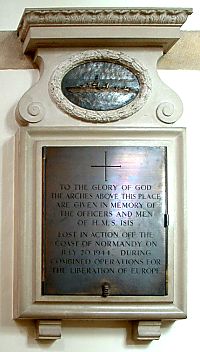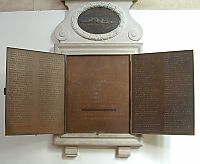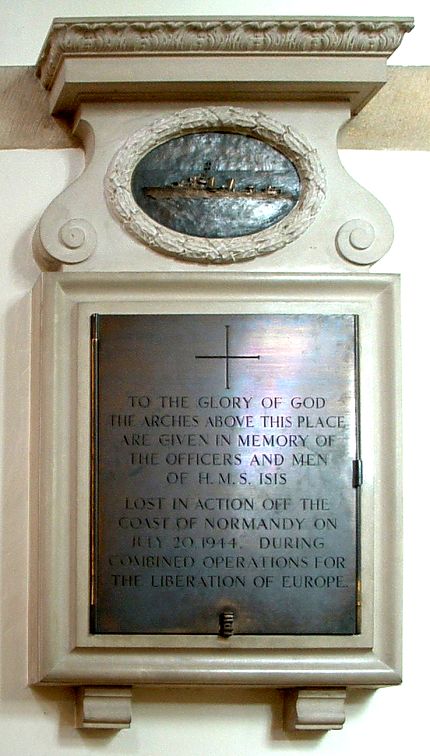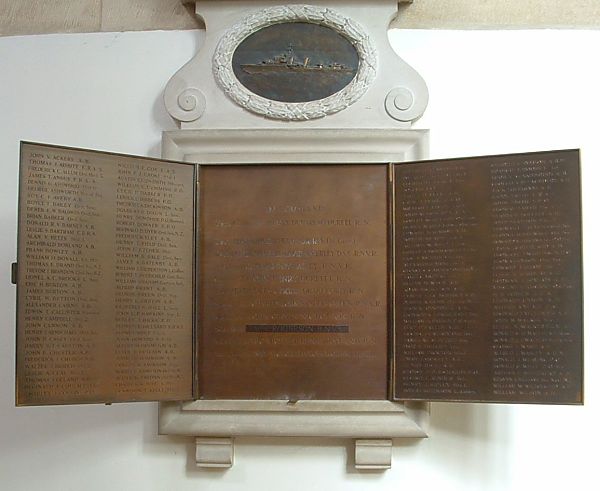Location
On a pillar at the west end of the Navy Aisle (see Cathedral Plan).
Description
It is stone and bronze with a detailed bronze cast of the ship above the main plaque which opens up to reveal the names of the 11 officers and 144 men lost.
THE ARCHES ABOVE THIS PLACE
ARE GIVEN IN MEMORY OF
THE OFFICERS AND MEN
OF H.M.S. ISIS.
LOST IN ACTION OFF THE
COAST OF NORMANDY ON
JULY 20 1944. DURING
COMBINED OPERATIONS FOR
THE LIBERATION OF EUROPE.
Inscription (Centre Plaque)
Lieut.Commander HENRY DUMARESQ DURELL RN
Lieut. FRANK HUGH SEYMOUR R. (1st Lieut)
Lieut. LIONEL MANFRED DAVID APPERLEY DSC.,RNVR.
Sub.Lieut. EDWARD ROY BAILEY RNVR
Gunner (T) JOHN HENRY BURFITT
RN Lieut.(E) DUDLEY GOODE DRAKEFORD RN
Surgeon Lieut. CHARLES JOHN SANDERS GREEN RNVR
Midshipman JOHN GIRVIN NICHOLSON RN
Sub.Lieut.JACK ROGERSON RNVR
Midshipman ERIC MICHAEL HENRY RYLAND RV
Sub.Lieut.HENRY VICTOR FRANCIS WORAM RNR
|
JOHN V. AKERS A.B. THOMAS J. AISBITT ERA5 FREDERICK C. ALLUM Ord.Mech.5. JAMES T. ANGUS ERA 4 DENNIS G. ASHWOOD Ord Sea GEORGE ASHWORTH Yeo of Sig ROY C.F. AVERY AB ROYCE BAILEY Ord.Sea DEREK E.W. BALDWIN Ord.Sea BRIAN BARKER Ord.Sea DONALD R.V. BARNES AB LESLIE S. BARTRAM, CERA ALAN V. BETTS Sto1 ARCHIBALD BORLAND A.B. FRANK BOWLEY A.B. WILLIAM H. BOXALL Ch.Sto. THOMAS E. BRAND Ord.Sea NZ. TREVOR J. BRANDON Ord.Sea NZ LIONEL A.C. BROOKS L.Sea ERIC H. BURTON A.B. JAMES BURTON A.B. CYRIL W. BUTTON Ord.Sea ALEXANDER CAIRNS A.B. EDWIN T. CALLISTER. Steward. HENRY CAMPBELL Sto.2. JOHN CANNON A.B. HENRY CARMICHAEL Ord.Tel. JOHN D. CASEY Ord.Sea. HARRY S.T. CAUSTON A.B. JOHN E. CHESTER A.B. FREDERICK J. CHURCH A.B. WALTER CHURCH Sto.1. LESLIE A. CLAY Sto.1. THOMAS CLELAND A.B. REGINALD J. COUCH P.O.Tel CHARLES J. COUSINS P.O. |
WILLIAM E. COX EA3 JOHN P.J. CROKE Sto.1 AUSTIN CUDWORTH Steward WILLIAM E. CUMMING P.O. CECIL P. DARKER P.O. LERICK L. DIBBENS P.O. FREDERICK DICKINSON A.B. DOUGLAS G. DIXON L.Sea HENRY DONOHOE P.O.Steward ROBERT DOWNER S.P.O. REGINALD D. DYER Ord.Sea NZ FREDERICK ELEY A.B. HENRY T. FIELD Ord.Sea JOHN FLETCHER Sto. WILLIAM R. GALE Ord.Sea. JAMES A. GATENBY A.B. WILLIAM J. GILBERTSON L.Coder ROBERT E. GOODCHILD Ord.Sea. WILLIAM GRAHAM Canteen Asst. ALFRED GRANT A.B. GEORGE GREEN Ord.Sig. HENRY L. GRIFFIN A.B. GEOFFREY G. HALL L.Sea. JOHN E.P. HAWKINS Sto1 DURLEY J. HICKS P.O. SYDNEY E. HILLYARD ERA3 SYDNEY HOLT Sto1 JOHN HAWARD S.P.O. ALBERT H. HULMSTON A.B. LESLIE F. HUTCHIN A.B. JOHN HUTCHINSON A.B. ERNEST A. JACKSON Sig. MORRIS E. JOHNSTONE Ord.Sea NZ ALLAN K. JORDON Ord.Sea NZ CHARLES S. JUPE L.Sto. DENNISON T. KELLY Sto2 |
Inscription (Right Door)
|
WILFRED KEOWN A.B. RONALD A.N. KING Sto1 REGINALD E. LEAR L.Sea JOSEPH LEE Sig. JAMES D. LEEL A.B. CYRIL J. LEWIS S.P.O. WILLIAM E. LLOYD Sto1 JOHN M. LOLLGAN E.R.A.3 ROBERT McKECHIN Ord.Sea. HENRY MANNERING Ord.Sea. EDWARD MARMION A.B. JOHN D. MEARNS Sto.1 ARTHUR W. MILLS L.Sto. ERNEST A. MONTGOMERY L.Sto. ERIC T. MORRIS Ord.Sea. ALEXANDER MUIR Sto1 GEORGE C.C. MUNRO Ord.Sea.NZ JAMES C. MURRAY Sto2 RESLYN NEWTON A.B. ADAM NICHOLSON A.B. ERNEST S.J.C. NORTHEY A.B. DENNIS A. NUNN Ord.Sea.NZ THOMAS O'DONNELL A.B. LEONARD A.J. PARKER Ord.Sea. WILLIAM H. PARKIN P.O.Cook BERT F. PATTEN A.B. HUGH C. PEARSON Ord.Sea JAMES McG. PETRIE Sig. IVOR R. PHILLIPS Tel. WILLIAM PROCTOR Sto1 EWAN J. QUIGLEY A.B. HENRY RICE A.B. GEORGE P.D. RICHARDS P.O. GEORGE E. RINDER Tel. HENRY J. RIPLEY Sto1 ROBERT ROBINSON L.Coder |
CHARLES E. ROBSON A.B.NZ FRANCIS J. ROONEY Tel. SIDNEY G. SAINSBURY A.B. GEOFFREY D. SAUNDERS A.B. JACK SHERWOOD A.B. HARRY SMITH ERA4 JOHN SMITH S.P.O. THOMAS SMITH Sto1 STANLEY SOLLITT A.B. JOHN STANTON Sto2 THOMAS E. STEVENS Ord.Sea. GEORGE H. STEWART Ord Sea HOWARD G. STURGESS P.O.Sig FRANK SUTHERLAND A.B. THOMAS E. SWADLING S.P.O. THOMAS SYRON Ord.Sea EDWARD TAYLOR Sto2 LESLIE R. TERRY OA4 NORMAN THOMSON A.B. VINCENT P. THORNE Ord.Sea. BEN TURNER S.B.A. LEONARD UNWIN A.B. ARTHUR A. VEALE P.O. REGINALD J. VELLENDER A.B. JOHN W. WALKER Sto2 LESLIE N. WALKER DSM, A.B. RONALD G.H. WALLIS A.B.Radar RONALD J.J. WALTERS Supply Asst. GEORGE S. WARD A.B. ALFRED I. WASLEY A.B.NZ RONALD J. WEAVING P.O. RONALD G. WEST P.O.Sto. ARTHUR E. WHITBREAD A.B. MERVYN A. WILLIAMS Rad.Mech. NZ WILLIAM W. WILLOUGHBY A.B. WILLIAM WILSON A.B. |
Further Information
The ship was an Intrepid Class destroyer (1,370t) built in Yarrow and launched in November 1936, it was sunk by human torpedo or mine off Normandy. It was on anti-submarine patrol off the Western Sector (Normandy Invasion). There were 20 survivors.
The names of those lost are commemorated on the CHATHAM NAVAL MEMORIAL and individual details can be obtained by searching against the names at www.cwgc.org
Two Survivors Accounts
1: Ken Davies D/JX, 420469
I came aboard Isis some 9 or 10 days before she was mined and not only witnessed the bombarding of German shore positions but also took part in the excitement of depth-charging a suspected U-boat. I
remember nothing of either event. It appears that the sights and sounds of the mine explosion and it's aftermath induced some sort of mental block. I nevertheless stand by my recollections of the mining itself and of my time on the Carley Float and subsequent rescue by the American Coast guard cutter.
I was on deck when the ship hit the mine. Shortly after this explosion there was a second, which I assumed was that of the boiler. On both occasions I was thrown to the deck. On seeing the for'ard hatch falling away, I began to release one of the Carley Floats. There must have been a dozen or more men just standing by the port rail obviously in shock and doing nothing to help themselves. They only came to life when the float hit the water. Naturally they were the first on.
The emotional strain of our situation was soon demonstrated. On my raft one young fellow's mind went - he kept talking to his mother whilst refusing to give up the paddle he was clutching. Another was wearing a Duffel Coat and a polar necked jumper. He was asked to give up his coat to cover a fellow who was wearing only a singlet and appeared to be badly scalded or burnt. Duffel coat refused. Someone suggested taking the coat off him but wiser heads said that a struggle would have us all in the water and if that happened some would not make it back to the float.
I remember the speed with which men died. The fellow next to me said he was feeling warm at last. This I knew was a sign of hypothermia. I tried to keep him awake by talking to him, but failed. It seemed no time at all before he was as stiff as a board and we tipped him over the side.
Just as the sun was about to disappear, we saw the silhouettes of two ships. They wouldn't have been much more than a mile away. Duffel coat stood up to shout and wave. Whether he stumbled or was given a nudge, I don't know, but he ended up in the water. I don't know if he got back on board or not, but then I didn't look for him; it was at this time that a man I was told was the ship's R.P.C. and I were fixing life-belt lights onto a paddle.
Eventually the American Coast Guard Cutter spotted us and nosed between our float and another, not realising that the two were roped together. This had the effect of turning our float onto it's starboard side. We had to quickly jump across to the cutter. I was second to jump and was terrified I would mistime my jump and end up in the water. In the event all went well and I was taken below and put in a bunk with white sheets!.
2: John Parlane, as related by his daughter Frances
Dad had finished his watch and had gone below to lie on his bunk and rest. He had just been paid off for his tour of duty, which meant when the ship went down so did two years pay! This kind of additional detail make more tragic a dreadful tale.
There was another man in the bunk below having his break too when the ship was hit by a torpedo. Dad was thrown upwards and banged his head on the ceiling then thrown onto the floor, his head and leg were bleeding. There was a second 'hit' which literally opened up the ship where Dad was. In the wall of his cabin there was a great big hole where he could see the sea outside. He shouted for the other man to swim out with him but the other guy declined the offer. Even though his room-mate was uninjured Dad never saw him again. Dad jumped for it and swam to one of the rafts which were filling up with survivors. There was no room for him to get on. With his head bleeding he managed to twist the ropes which ran alongside the raft around his wrists to keep him attached to the boat. He thought his head wound was his worst injury and didn't realise that he had a serious back injury, one that would keep him flat on his back for the next three months. He stayed all night in the water watching men falling off the
raft and dying. These men had no physical injuries, they had been suffering from exposure; hypothermia. Eventually there was space and Dad was able to get up onto the raft. From there he was rescued the next morning.
The rescue involved Dad being taken ashore strapped to a stretcher because of his back injury. In the hubbub of activity on the
dockside, the rescuers thought my dad was American because of his accent. He had been born on Gibraltar and lived in Southern Spain for the early part of his life. He moved to North Wales as a teenager and learned to speak broken Welsh with English. It was with a strange accent that Dad managed to persuade a Red Cross Padre that he was English and should not be loaded onto a plane bound for America with all the other American shell shocked souls who were also strapped to stretchers! I remember him telling me that he actually held the Padre by the collar and said he wouldn't let him go until he sorted out that Dad was who he said he was. The Padre believed Dad and not only steered him in the right direction for medical care but also let Dad write a few scribbled words onto the back of an envelope.
Mum was to be told in those early days that Dad was missing in action presumed dead. What the War Office didn't know was that Mum had received a note addressed to her in Dad's shaky but inimitable hand writing saying 'hurt my hand write soon Jack'. Although it was some time before Mum heard anything else about Dad's welfare, she held on to the belief that he was alive somewhere.
Dad was taken from the the dock side to a military hospital in Yeovil where he was nursed back to health. He told me how he wished that the war was over for him at that point but the Navy had other ideas and when he was fit he was sent to another ship.
He had other accounts of all the ships he had served on during the Second World war. He said they were all were mine sweepers or mine layers. One day a request was sent round asking for volunteers to serve on a submarine; the Navy were getting desperate. Normally no one wanted to serve on a submarine because it was too dangerous, but because of the dangers faced by these men on mine layers and sweepers Dad said every hand went up! He was not chosen.
Many of the ships my Dad served on during the war sank. You can imagine the teasing Dad had with a tale like that! But in reality Dad suffered a great deal; after one sinking he was sent home for three weeks leave and he told me he couldn't stop shaking for the whole time and was terrified of going back. But go back he did.
I am sure my account is not totally accurate. I hope it gives a taste of the difficulties which these men lived through and of the bravery which cost them so dearly. I am sure that more families than mine consider their loved one a hero too!




